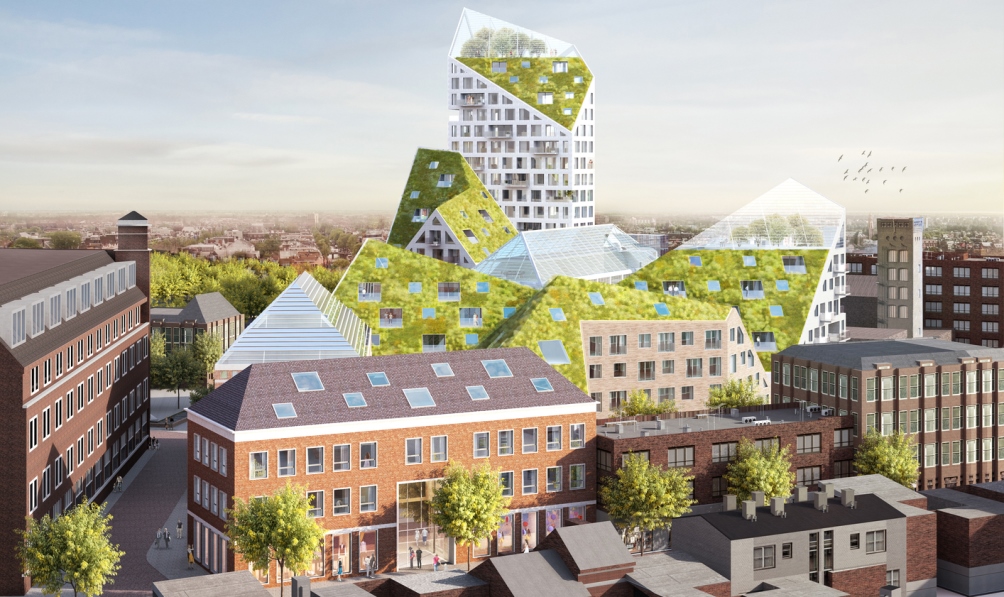Eindhoven a city in the south of the Netherlands, with a 2015 population of 223,220. Founded in 1232, it is now the country’s fifth-largest municipality.
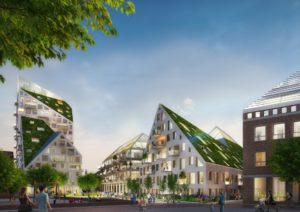 In July of 2017, Amsterdam-based architects MVDRV and design firm SDK Vastgoed (VolkerWessels) were selected to design a progressive residential redevelopment project called Nieuw Bergen in inner-city Eindhoven.
In July of 2017, Amsterdam-based architects MVDRV and design firm SDK Vastgoed (VolkerWessels) were selected to design a progressive residential redevelopment project called Nieuw Bergen in inner-city Eindhoven.
Nieuw Bergen is set to become a unique part of the city center of Eindhoven, and combines repurposed, renovated, and transformed existing buildings with new construction.
The 29,000m2 project of seven buildings will include 240 new homes, 1,700m2 of commercial redevelopment, 270m2 of urban farming space, and underground parking.
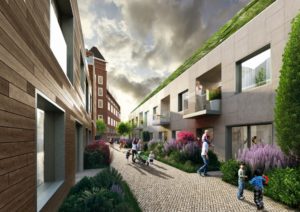 The urban strategy applied here is based on the knowledge and innovation necessary for establishing a sustainable, pleasant and dynamic living environment for future residents. The design approach echoes Eindhoven’s status as a city of technology, design and knowledge. Nieuw Bergen will get a hyper-modern feel and continues the informal character of the Bergen neighbourhood.
The urban strategy applied here is based on the knowledge and innovation necessary for establishing a sustainable, pleasant and dynamic living environment for future residents. The design approach echoes Eindhoven’s status as a city of technology, design and knowledge. Nieuw Bergen will get a hyper-modern feel and continues the informal character of the Bergen neighbourhood.
“Natural light plays a central role in Nieuw Bergen, as volumes follow a strict height limit and a design guideline that allows for the maximum amount of natural sunlight, views, intimacy and reduced visibility from street levels,” says Jacob van Rijs, co-founder of MVRDV. “Pocket parks also ensure a pleasant distribution of greenery throughout the neighbourhood and create an intimate atmosphere for all.”
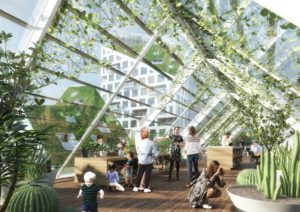 Imaginary planes at an angle of 45 degrees are drawn from the footprint of neighboring residential buildings which leads to natural light principles that result in unpredictable building forms with jagged silhouettes, a modern and optimistic atmosphere. At the same time, these refer traditional pitched roofs.
Imaginary planes at an angle of 45 degrees are drawn from the footprint of neighboring residential buildings which leads to natural light principles that result in unpredictable building forms with jagged silhouettes, a modern and optimistic atmosphere. At the same time, these refer traditional pitched roofs.
The 45-degree angle results in maximum sunlight for both houses and public space hence creating an optimum environment with significant energy savings as a result. The oblique roof planes are ideally suited for installing solar panels and also accommodate green roofs. This concept is an evolution of the urban strategy tool MVRDV has been developing and actively applies in cities in need of sustainable densification.
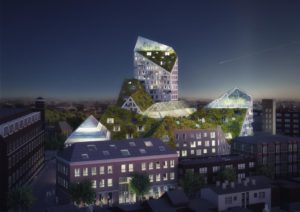 Individual buildings within Nieuw Bergen are different, yet they all collectively form a family of buildings that fit into the existing context like a mosaic. The sloping roofs reinforce this diversity and create a varied roof landscape. The diverse roofscape with solar panels and green make for an eye-catching and sustainable character. Angled roofs are less visible from the ground floor and result in a more intimate city. Collective gardens and greenhouses with lamella roof structures crown a number of buildings.
Individual buildings within Nieuw Bergen are different, yet they all collectively form a family of buildings that fit into the existing context like a mosaic. The sloping roofs reinforce this diversity and create a varied roof landscape. The diverse roofscape with solar panels and green make for an eye-catching and sustainable character. Angled roofs are less visible from the ground floor and result in a more intimate city. Collective gardens and greenhouses with lamella roof structures crown a number of buildings.
A conscious choice of neutral colors and textured materials with subtle differences inform the striking glazed ceramic facades. Other façade materials incorporate stone, wood and concrete elements and the color palette varies from white to grey; and shiny to rough. Wall openings also follow this diversity of architecture and varied positioned balconies with generous outdoor spaces create a vivid and attractive living environment.
All images courtesy of MVRDV.

